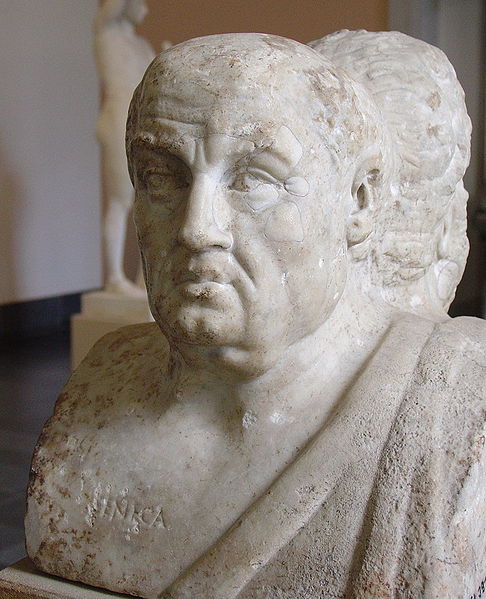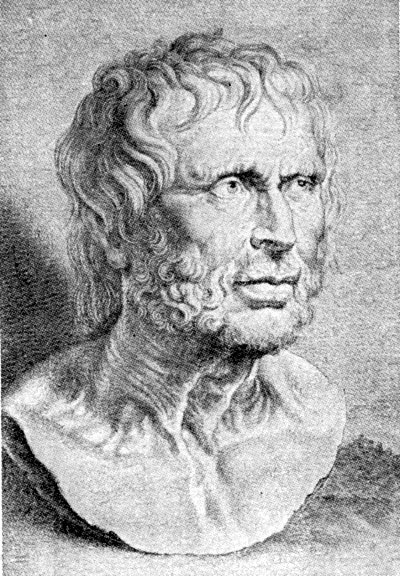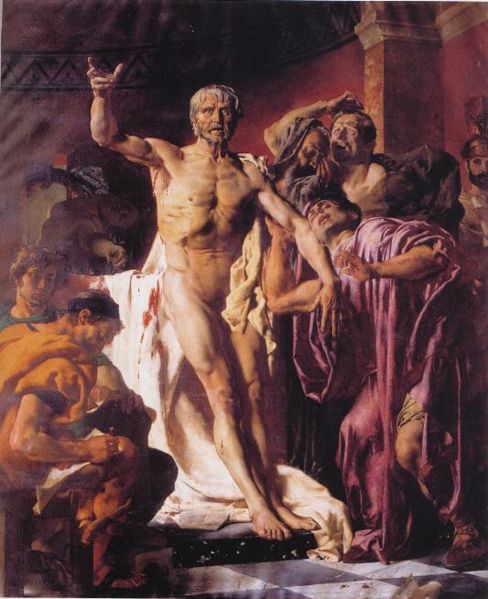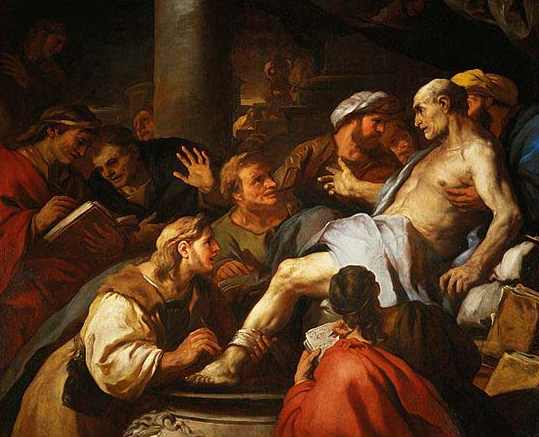<Back to Index>
- Philosopher and Statesman Lucius Annaeus Seneca, 4 B.C.
PAGE SPONSOR


Lucius Annaeus Seneca (often known simply as Seneca) (ca. 4 BC – 65 AD) was a Roman Stoic philosopher, statesman, dramatist, and in one work humorist, of the Silver Age of Latin literature. He was tutor and later advisor to emperor Nero. While he was later forced to commit suicide for alleged complicity in the Pisonian conspiracy to assassinate Nero, the last of the Julio - Claudian emperors, he may have been innocent. His father was Seneca the Elder and his older brother was Gallio.
Lucius Annaeus Seneca was born in Cordoba, in the Baetica, the southern highly romanized province of Spain. One of his revisionist modern biographers, however, Miriam Griffin says in her biography of Seneca that "the evidence for Seneca's life before his exile in 41 is so slight, and the potential interest of these years, for social history as well as for biography, is so great that few writers on Seneca have resisted the temptation to eke out knowledge with imagination." Griffin also states, apparently inferring from ancient sources, that Seneca was born in either 8, 4, or 1 BC. She thinks he was born between 4 and 1 BC and was resident in Rome by 5 AD. Seneca says that he was carried to Rome in the arms of his mother's stepsister. Griffin says that, allowing for rhetorical exaggeration, means "it is fair to conclude that Seneca was in Rome as a very small boy." Be that as it may, it is clear that he was in Rome at a relatively early stage in his life.
His family was from Cordoba in Hispania (the Iberian Peninsula) and, like his father, Lucius Annaeus Seneca "the elder," he was born there. According to Griffin, the family originally probably came from Etruria or the "area further east towards Illyria."
He was the second son of Helvia and Lucius Annaeus Seneca, the wealthy rhetorician known as Seneca the Elder. His older brother, Gallio, became proconsul in the Roman province of Achaea. His younger brother Annaeus Mela's son was Marcus Annaeus Lucanus.
At Rome he was trained in rhetoric and was introduced to Hellenistic Stoic philosophy by Attalus and Sotion. Seneca's own writings describe his poor health. At some stage he was nursed by his aunt; as she was in Egypt from 16 to 31 AD, he must have at least visited and perhaps lived there for a period.
Seneca and his aunt returned to Rome in 31, and she helped him in his campaign for his first magistracy.
Caligula began his first year as emperor in 38, and there was a severe conflict between him and Seneca; the emperor is said to have spared his life only because he expected Seneca's natural life to be near its end.
In 41, Claudius succeeded Caligula, and then, at the behest of his third wife Valeria Messalina, banished Seneca to Corsica on a charge of adultery with Caligula's sister Julia Livilla. Seneca spent his exile in philosophical and natural study (a life counseled by Roman Stoic thought) and wrote the Consolations, fulfilling a request for the text made by his sons for the sake of posterity. In 49, Claudius' fourth wife Agrippina the Younger had Seneca recalled to Rome to tutor her son Nero, then 12 years old; on Claudius' death in 54, she secured recognition of Nero, rather than Claudius' son Britannicus, as emperor.
From 54 to 62, Seneca acted as Nero's advisor, together with the praetorian prefect Sextus Afranius Burrus. Seneca's influence was said to be especially strong in the first year. Many historians consider Nero's early rule with Seneca and Burrus to be quite competent. However, over time, Seneca and Burrus lost their influence over Nero. In 59 they had reluctantly agreed to Agrippina's murder, and afterward Seneca wrote a dishonest exculpation of Nero to the Senate. With the death of Burrus in 62 and accusations of embezzlement, Seneca retired and devoted his time again to study and writing.
There is also speculation in Peter Salway's History of Roman Britain that Seneca had been involved in forcing large loans on the indigenous British aristocracy in the aftermath of Claudius's Roman conquest of Britain, and then calling them in suddenly and aggressively. The suggestion is that this contributed to Boudica's rebellion, and so possibly to his own fall.
In 65, Seneca was caught up in the aftermath of the Pisonian conspiracy,
a plot to kill Nero. Although it is unlikely that he conspired, he was
ordered by Nero to kill himself. He followed tradition by severing
several veins in order to bleed to death, and his wife Pompeia Paulina attempted to share his fate. Tacitus (writing in Book XV, Chapters 60 through 64 of his Annals of Imperial Rome,
a generation later, after the Julio - Claudian emperors) gives an account
of the suicide, perhaps, in light of Tacitus's Republican sympathies,
somewhat romanticized. According to it, Nero ordered Seneca's wife to be
saved. Her wounds were bound up and she made no further attempt to kill
herself. As for Seneca himself, his age and diet were blamed for slow
loss of blood, and extended pain rather than a quick death; taking
poison was also not fatal. After dictating his last words to a scribe,
and with a circle of friends attending him in his home, he immersed
himself in a warm bath, which was expected to speed blood flow and ease
his pain. Tacitus writes: “He was then carried into a bath, with the
steam of which he was suffocated, and he was burnt without any of the
usual funeral rites. So he had directed in a codicil of his will, even
when in the height of his wealth and power he was thinking of life’s
close.”
The early Christian Church was very favorably disposed towards Seneca and his writings, and the church leader Tertullian called him "our Seneca".
Medieval writers and works (such as the Golden Legend, which erroneously has Nero as a witness to his suicide) believed Seneca had been converted to the Christian faith by Saint Paul, and early humanists regarded his fatal bath as a kind of disguised baptism. However, this seems unlikely as Seneca always professed to be Stoic.
Dante placed Seneca in the First Circle of Hell, or Limbo,
a place of perfect natural happiness where virtuous non - Christians such
as the ancient philosophers had to stay for eternity, due to their lack
of the justifying grace (given only by Christ) required to go to heaven. Seneca makes an appearance as a character in Monteverdi's opera L'incoronazione di Poppea.
Seneca remains one of the few popular Roman philosophers from the period. He appears not only in Dante, but also in Chaucer and to a large degree in Petrarch, who adopted his style in his own essays and who quotes him more than any other authority except Virgil. In the Renaissance, printed editions and translations of his works became common, including an edition by Erasmus and a commentary by John Calvin. Ralph Waldo Emerson, John of Salisbury, Erasmus and others celebrated his works. French essayist Montaigne, who claimed not to have studied on Seneca and Plutarch, was himself considered by Pasquier a "French Seneca"; similarly, Thomas Fuller praised Joseph Hall as "our English Seneca". Many who have considered his ideas not to be particularly original, still argued he was important in making the Greek philosophers presentable and intelligible.
Even with the admiration of an earlier group of intellectual stalwarts, Seneca is not without his detractors. In his own time, he was widely considered to be a hypocrite or, at least, less than "stoic" in his lifestyle. His tendency to engage in illicit affairs with married women and close ties to Nero's excess test the limits of his teachings on restraint and self - discipline. While banished to Corsica, he wrote pleas for restoration rather incompatible with his advocacy of a simple life and the acceptance of fate. In his Pumpkinification (54) he ridiculed several behaviors and policies of Claudius that every Stoic should have applauded; a reading of the text shows it was also an attempt to gain Nero's favor by flattery — such as proclaiming that Nero would live longer and be wiser than the legendary Nestor. Suilius claims that Seneca acquired some "three hundred million sesterces within the space of four years" through Nero's favor. Robin Campbell, a translator of Seneca's letters, writes that the "stock criticism of Seneca right down the centuries [has been]...the apparent contrast between his philosophical teachings and his practice."
According to Tacitus however, Suilius's accusations did not hold up under scrutiny. It would make sense that Seneca's position of power would make him vulnerable to trumped up charges, as many public figures were at the time.
In 1966 scholar Anna Lydia Motto also challenged this view of Seneca, arguing that his image has been based almost entirely on Suilius's account, while many others who might have lauded him have been lost.
"We are therefore left with no contemporary record of Seneca's life, save for the desperate opinion of Publius Suilius. Think of the barren image we should have of Socrates, had the works of Plato and Xenophon not come down to us and were we wholly dependent upon Aristophanes' description of this Athenian philosopher. To be sure, we should have a highly distorted, misconstrued view. Such is the view left to us of Seneca, if we were to rely upon Suilius alone."
More recent work is changing the dominant perception of Seneca as a mere conduit for pre - existing ideas showing originality in Seneca's contribution to the history of ideas. Examination of Seneca's life and thought in relation to contemporary education and to the psychology of emotions is revealing a relevance of his thought. For example, Martha Nussbaum in her discussion of desire and emotion includes Seneca among the Stoics who offered important insights and perspectives on emotions and their role in our lives. Specifically devoting a chapter to his treatment of anger and its management she shows Seneca's appreciation of the damaging role of uncontrolled anger, and its pathological connections. Nussbaum later extended her examination to Seneca's contribution to political philosophy showing considerable subtlety and richness in his thoughts about politics, education and notions of global citizenship and finding a basis for reform minded education in Seneca's ideas that allows her to propose a mode of modern education which steers clear of both narrow traditionalism and total rejection of tradition.
Some
writers regard Seneca as the first great western thinker on the complex
nature and role of gratitude in human relationships. There
has also been a recent theory presented that there were in fact two
Senecas. While the evidence seems marginal at best, a small number of
doctorate works have noted stylistic discrepancies across the corpus of
Senecan work. The theory, though a published dissertation, has been
roundly viewed as incorrect.
Works attributed to Seneca include a dozen philosophical essays, one hundred and twenty - four letters dealing with moral issues, nine tragedies, a satire, and a meteorological essay. One of the tragedies attributed to him, Octavia, has been argued as having been written by another. His authorship of Hercules on Oeta has also been questioned.
Seneca generally employed a pointed rhetorical style. His writings expose traditional themes of Stoic philosophy:
the universe is governed for the best by a rational providence;
contentment is achieved through a simple, unperturbed life in accordance
with nature and duty to the state; human suffering should be accepted
and has a beneficial effect on the soul; study and learning are
important. He emphasized practical steps by which the reader might
confront life's problems. In particular, he considered it important to
confront one's own mortality. The discussion of how to approach death
dominates many of his letters.
Many scholars have thought, following the ideas of the 19th century German scholar Leo, that Seneca's tragedies were written for recitation only. Other scholars think that they were written for performance and that it is possible that actual performance had taken place in Seneca's lifetime. Ultimately, this issue cannot be resolved on the basis of our existing knowledge.
The tragedies of Seneca have been successfully staged in modern times. The dating of the tragedies is highly problematic in the absence of any ancient references. A relative chronology has been suggested on metrical grounds but scholars remain divided. It is inconceivable that they were written in the same year. They are not all based on Greek tragedies, they have a five act form and differ in many respects from extant Attic drama, and whilst the influence of Euripides on some of these works is considerable, so is the influence of Virgil and Ovid.
Seneca's plays were widely read in medieval and Renaissance European universities and strongly influenced tragic drama in that time, such as Elizabethan England (Shakespeare and other playwrights), France (Corneille and Racine), and the Netherlands (Joost van den Vondel). He is regarded as the source and inspiration for what is known as 'Revenge Tragedy', starting with Thomas Kyd's 'The Spanish Tragedy' and continuing well into the Jacobean Period.
- A gem cannot be polished without friction, nor a man perfected without trials.
- A great fortune is a great slavery.
- A large part of mankind is angry not with the sins, but with the sinners.
- A man who suffers before it is necessary, suffers more than is necessary.
- A person's fears are lighter when the danger is at hand.
- A quarrel is quickly settled when deserted by one party; there is no battle unless there be two.
- A sword never kills anybody; it is a tool in the killer's hand.
- As long as you live, keep learning how to live.

